
|
δ EDWARD D. WALKER (BRITISH, B. 1931)
Portrait of the battleship H.M.S. 'Vanguard'
Signed 'E.D. Walker' (lower right)
Oil on canvas
19½ x 29in. (49.5 x 74.5cm.)
£150-250
52.
Capt. Ralph Douglas Binney C.B. (British, 1888-1944)
Warships at anchor at Portsmouth Harbour
Watercolour
13½ x 20¾in. (34.5 x 52.5cm.)
Provenance: Angela Binney (daughter); Private collection (letter to reverse)
£200-400
|
|

|
δ DAVID COBB (BRITISH, 1921-2014)
H.M.S. 'Ark Royal' (1950)
Signed 'David Cobb' (lower left)
Oil on canvas
9 x 15in. (23.5 x 39cm.)
£150-250
|
|
|
|

|
δ CHARLES PEARS (BRITISH, 1873-1958)
A battleship coaling at sea during WW1
Lithograph
14 x 17¾in. (35.5 x 45cm.)
£200-400
|
|

|
δ NORMAN WILKINSON (BRITISH, 1878-1971)
Battle cruiser H.M.S 'Lion' in Portsmouth Harbour
Signed 'Norman Wilkinson' (lower left); 'Beatty' (lower right)
Etching
Pl. 13½ x 13¾in. (34 x 35cm.)
£400-600
|
|

|
WILLIAM LIONEL WYLLIE (BRITISH, 1851-1931)
Battle Cruiser Squadron at Jutland, 1916
Signed in pencil
Etching
Pl. 6½ x 16½in. (17 x 42cm.)
£150-250
|
|

|
WILLIAM LIONEL WYLLIE (BRITISH, 1851-1931)
The Q-Boat 'Merope' sinking a U-Boat,
Signed in pencil 'W.L. Wyllie' (lower left)
Etching
PL. 6¾ x 9in. (17.5 x 23cm.); Together with another by the same hand. A stranded derelict, signed in pencil 'W.L. Wyllie' (lower left), Etching - 10 x 15in. (25.5 x 38cm.)
(2)
£200-400
|
|

|
CHARLES OLDFIELD BOWLES (BRITISH, 1785-1862)
Two sketchbooks of pencil and wash drawings, the majority maritime and landscape subjects including: Portsmouth; Cowes; Grasshopper, Bay of Naples; Coast near Castle Nuovo; Ponza; Impregnable; Naples Bay; Boyne, Castle St Elmo; Elba; Flushing; racing cutters; The Royal Yacht Squadron; and others, some inscribed and dated '1815'
pencil and grey wash
Sketchbook: 7¼ x 10½in. (18.5 x 26.5cm.); and smaller
(2)
Provenance: Christie's 8th November 2006, Lot 324
£400-600
|
|

|
AN ALBUM CONTAINING A COLLECTION OF WATERCOLOURS, 19TH CENTURY
including an estuary landscape by William Payne (British, 1760-1830); a pen and ink drawing of 'H.M.S. Amethyst … capturing the French Frigate La Niémen 1809'; and numerous other lithographs, coloured prints and drawings, the album - 14¾ x 11in. (37.5 x 28cm.)
(A lot)
£200-300
|
|

|
A VERY FINE WATERCOLOUR ALBUM DETAILING DIFFERENT SHIP TYPES OF THE FRENCH NAVY, 1805
signed and entitled on frontispiece A[ma]dée Le Bel / Recueil de Vaisseux de differentes Grandeurs... and dated 1805. V.S. Ans 14em de la Repub., laid paper comprising a fine title consisting of naval appurtenances in various colours, 26 pages adorned with 59 finely drawn, captioned and coloured mainly French with some English naval vessels of varied sizes, dimensions table and compass rose end paper, contemporary boards - 10¾ x 8½in. (27.3 x 21.5cm.)
£6000-8000
|
|
  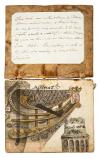 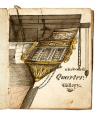 |
A UNIQUE ALBUM OF CONTEMPORARY WATERCOLOURS OF THE FRIGATE H.M.S. JASON BY THE SHIP'S CARPENTER, AND BOUND IN MONKEY SKIN, CIRCA 1805
compiled by Thomas Harris and comprising ships drawings, manuscript on paper, 7 watercolour drawings of ships' details, the second one with a Union Jack and an early 19th century pen and ink drawing of a figure, and 5pp describing ordnance Dementions of 1st Rate 110 Guns 2764 Tons, etc. Bound exotically in monkey skin, a little worn, contained in a recessed space in a modern green morocco chemise, c.1805. With an inscription on the inside cover of the book: This book was written and drawn by Thomas Harris cabinet maker, of Shrewsbury. He was formally ship carpenter to the Jason frigate and made a model of it which I bought. He gave me this book at that time about June 1836. The binding is made of the skin of a monkey he brought from Jamaica - 4½ x 3¾in. (11.5 x 9.5cm.)
The Jason was a 32-gun fifth rate Thames Class frigate, launched Woolwich 1804, she became flagship to Admiral Alexandre Cochrane in June 1805 and, serving in the Leeward Islands, enjoyed a lively career. Capturing several French and Spanish vessels (including the Naiade after a nine hour chase), she was handed over to Capt. Thomas John Cochrane (the Admiral's son) and continued much as before. Frigate actions, reducing batteries, and surviving an attempted mutiny whilst in New York, her last acts were to serve as escorts to the restored French King, Louis XVIII, and the Prussian and Russian Emperors during the peace negotiations that heralded the end of the Wars in 1815. Worn out, she was broken up shortly afterwards
£3500-4500
|
|
   |
FREDERICK CHAPMAN: ARCHITECTURA NAVALIS MERCATORIA
Stockholm [no publisher], 1768, First Edition, engraved throughout, double page pictorial title by Arre, double-page dedication and 62 double-page plates, bound in a very good copy of modern half calf, modern gilt title label on front cover, folio - 23¾ x 18¼in. (60.5 x 46.5cm.)
This splendid and impressively-sized production represents the most important work of naval architecture of the 18th century, surpassing Jombert, Duchamel du Monceau and other works by naval architects. An Englishman, Frederick Henry Chapman (1721-1808) was manager of the shipyard at Karlskrona and, under the direction of Gustav III, was the founder of the modern Swedish navy. This first edition (there were several printed later) is rare, partly owing to its practical use in shipyards of the period
£7000-9000
|
|

|
A SET OF TECHNICAL DRAWINGS BY PIERRE OZANNE, PRODUCED TO ILLUSTRATE PIERRE-ALEXANDER FORFAIT'S TRAITÉ DE LA MÂTURE DES VAISSEAUX, À L'USAGE DES ÉLÈVES DE LA MARINE, CIRCA 1788
comprising 18 numbered pages of numerous original technical drawings mainly about masts, on laid paper in pen and ink, and pen and wash, contained within a later quarter calf folding box, the drawings 14 x 9¾in. (35.5 x 24.5cm); together with Pierre-Alexandre FORFAIT: Traité élémentaire de la mâture des vaisseaux, à l'usage des élèves de la marine, published by Clousier, Paris, 1788 (1st Edition), tables, technical vocabulary, 294 pages, plus 22 folding engraved plates, contemporary French mottled calf, gilt decorated spine in compartments including a red Morocco title piece - 10½ x 8½in. (26.5 x 21.5cm.)
(2)
The printed version included with this lot comprises 24 folding engraved plates, these drawings are about double the size of the engraved versions, and contain period corrections.
Pierre Ozanne (1737-1813) together with his brother Nicholas, was one of the most significant naval draughtsmen of mid-late 18th Century France and amongst other services, was Professor of Drawing at the Naval Academy; The Marine Engineer Pierre-Alexandre Forfait (1752 -1807), was the author of many works, some of which have been published. The Traité de la mature.. was ordered by the Ministry De Castries, for the education of Naval Cadets. The success of the book made Forfait a member of the Académie des Sciences.
£5000-8000
|
|

|
JOANNES LOCCENIUS: DE JURE MARITIMO & NAVALI LIBRI TRES
Stockholm, J. Jansson, 1650, additional engraved title, contemporary vellum, lacks ties - 5¼ x 3in. (13 x 7.5cm.)
Early Swedish treatise on navigation, written in Latin.
£200-300
|
|
| |
NAVAL LIST, A LIST OF THE FLAG OFFICERS AND OTHER COMMISSIONED OFFICERS OF HER MAJESTY'S FLEET, 1838
two leaves at the beginning detached, contemporary half-calf by Harmsworth, bookplate of the Royal Victorian Club, London, Clowes, 1838; together with Brenton's Naval History of Great Britain, 1783-1836, 2 vols., engraved portraits and plates, folding engraved plans, occasional foxing and offsetting, contemporary half-roan, spine of vol. I detached but preserved, 8vo, London, Colburn 1837; and a modern printing of the list of the Naval General Service Medal, Recipients, 1808-27
(4)
£150-250
|
|
| |
JAMES, WILLIAM, THE NAVAL HISTORY OF GREAT BRITAIN, FROM THE DECLARATION OF WAR BY FRANCE IN 1793, TO THE ACCESSION OF GEORGE IV … A NEW EDITION LONDON, R. BENTLEY, 1837
6 vols., 8vo, engraved portrait frontispieces, 19 folding printed tables, a few diagrams (a little foxing and waterstaining), original cloth, uncut (spines a little faded), bookplate of Glenalmond College Library
(6)
£150-250
|
|
| |
STEAMSHIP FLAG & FUNNEL RECOGNITION BOOKS
comprising Reed's, 4th edition, 1912 (648 entries); Brown's, 1st edition, 1926 (660 entries); Stewart's, revised by Styring, 6th edition, 1963 (1010 entries); Loughram's survey, 1st edition, 1979, with 33 full-page colour plates; and the U.S. Navy Hydrographic office's Merchant Marine House Flags and Stack Insignia, 1st edition, 1961, on 199 coloured pages, this last in official heavy-duty loose-leaf binder as issued, all excellent condition
(5)
£100-150
|
|

|
JOHN CHARNOCK: 'A HISTORY OF MARINE ARCHITECTURE'
printed for R. Faulder and others, London, 1802 in 3 vols., additional engraved title in vol. I with circular vignette by Shipster after West and 98 (of 99) engraved plates by Grieg, Newton, Tomkins and others, black stamp of Hampshire Library on titles, all plates with blindstamp of Wolverhampton Free Library (some foxing and offsetting), modern buckram - 12 x 10in. (30.5 x 25.5cm.)
(3)
£300-500
|
|

|
ALBIN ROBERTS BURT (BRITISH, 1783-1842)
Portrait of Lord Nelson circa 1802
Signed 'A R Burt' (lower right on shoulder)
Pencil on silk framed within contemporary gilt brass and wood frame
Image - 1¾in. (4.5cm.) diameter
Provenance: UK Private Collection
This attractive and unrecorded portrait is highly distinctive for being executed on silk, a very rare medium for any artist to choose and, indeed, no other example is recorded for this artist suggesting this was an image done from life on a napkin or handkerchief. A. R. Burt would have been uniquely placed to do this as his brother, Henry Frederick Burt was secretary to Lord Nelson, his mother was a close friend of Emma Hamilton, and Albin himself was a friend of Sir William Hamilton. Burt began his life as an engraver, training under Robert Threw and Benjamin Smith but branched out and an advert he applied to the back of some of his pictures states he had New invented a machine by which the most accurate likenesses can be taken. Can with confidence recommend his portraits to the public, especially as the practice of many Thousands has give his Pencil a facility that enables him to afford the coloured Profiles at / Half-a-Guinea each / and more finished at 1 Guinea
This image - in any format - is not recorded in the late Richard Walker's seminal 1998 volume The Nelson Portraits and, perhaps not surprisingly, is not recorded in the same author's 1985 volume Regency Portraits. It must therefore be considered an important discovery
Charles Miller Ltd would like to thank Claudia Hill of Ellison Fine Art for her invaluable assistance with this lot
£8000-12000
|
|

|
NELSON'S FUNERAL, 9TH JANUARY 1806
an unissued ticket for the funeral procession "from the Admiralty to St Paul's Cathedral", copper engraved and printed on stiff card - 5¾ x 6¾in. (14.5 x 17cm.)
£250-350
|
|

|
NELSON, HIS LIFE & TIMES, IN POSTCARDS
a comprehensive collection of approximately 300 postcards, both used and unused, coloured and monochrome, illustrating the life and times of Nelson, including portraits, battle scenes, H.M.S. Victory and numerous other related subjects, many different publishers, all contained in a modern album; with assorted duplicates (18), two 'sets' of cards, H.M.S Victory (6) and Wyllie's Trafalgar Panorama (3), both in original printed paper envelopes as issued; and a copy of David Shannon's 1987 catalogue of Nelson postcards published by the Nelson Society
(A lot)
£600-800
|
|
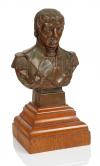 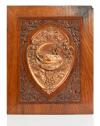 |
A FOUDROYANT COPPER BUST OF NELSON
after Flaxman with provenance impressed to rear of socle, and maker's mark 'R&I' to left shoulder, mounted on wooden base, 10½in. (25.5cm.) high; together with a Foudroyant copper and oak wall plaque depicting the wreck with period provenance label behind; a shoe horn; a copper roundel; a snuff box; a copper repoussé picture of Victory, an iron cannonball from Victory and two cast iron fireplace plaques for Lords Nelson and Howe
(9)
£250-350
|
|

|
PROOF NELSON MEZZOTINT, AFTER JOHN HOPPNER, 1805-06
a proof copy of Charles Turner's mezzotint, after the iconic image by John Hoppner of Nelson standing left in full dress uniform, but lacking all the caption details on the published versions, with small facsimile signatures of Hoppner and Turner below (within the plate line), attractive contemporary hand-colouring, mounted and framed for display - 35 x 26in. (89.5 x 65.5cm.) overall
First published as a print on 9th January 1806, this untitled proof was undoubtedly run off slightly earlier, in late 1805
£400-600
|
|
 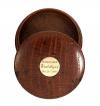 |
A GOLD-MOUNTED SNUFF BOX MADE FROM TEMERAIRE TREEN
the plain oak box with inset gold roundel inscribed TEMERAIRE / Trafalgar / Oct. 21st, 1805 - 3in. (7.5cm.) diameter
£250-350
|
|

|
SOUVENIRS FROM MERTON
comprising an apparently unused stiff leather hat cockade with 'chelengk' and ribbon; a cast brass lion's mask door knob; and a small section of green wax jack taper in box with provenance, the cockade - 5½in. (14cm.) high
(3)
A label on the door knob alleges it was recovered from Merton during its demolition in the 1920's; the wax taper has a note alleging a connection to Nelson at Trafalgar; the cockade comes from the same source, the only corroboration perhaps being the addition of the chelengk motif
£150-250
|
|

|
A SNUFF BOX CARVED FROM SHANNON TREEN
the lid carved with a rose-type design and inscribed around the edge SHANNON / JUNE 13 1813 - 3½in. (9cm.) diameter
H.M.S. Shannon (Capt. Broke) defeated U.S.S. Shannon (Capt. Lawrence) in a short, bloody action of just 15 minutes on 1st June 1813. Lawrence was killed and buried with full military honours by the British and latterly Shannon was renamed St. Lawrence.
£400-600
|
|

|
AN 18TH/19TH CENTURY OAK AND BRASS SHIP'S BUCKET
coopered with brass retaining rings and ropework handle, stamped with broad arrow on the underside - 14¼in. (36cm.) high
£200-300
|
|

|
A COLLECTION OF EARLY 19TH CENTURY BALEEN, LEAD AND TWINE BO'SUN'S 'STARTERS'
comprising four examples with twisted baleen shafts with twine-covered lead ends, the largest - 13in. (33cm.); together with a brass-ended wooden truncheon and small wooden fid
(6)
£300-500
|
|
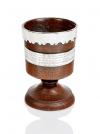 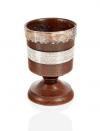 |
A SILVER-MOUNTED GOBLET MADE FROM QUEBEC TREEN, CIRCA 1779
with pie-crust rim and cartouche inscribed This cup was part of the Quebec which after having Silenced her Enemy Surveillante was blown up off Ushant the 6 day of Oct 1779 due honor to the Captain Farmer and his brave seamen - 5½in. (14cm.) high
£150-250
|
|

|
'A RELIC OF THE ROYAL GEORGE'
published by E. & E. Emanuel, 1840, the covers counterstamped with their mark; together with a fourth edition, 1841; and a ninth edition, 1847
(3)
£250-350
|
|

|
A KETTLE MADE FROM ROYAL GEORGE COPPER
the side inscribed with provenance cartouche and depiction of the disaster, the lid inscribed Red Hot and the folding carry handle signed M & R Wright 1843 - 5in. (12.5cm.) high (excluding handle); together with a bowl made from Royal George oak, the lid inscribed The Royal George sunk 1782 - 5¼in. (13cm.) high
(2)
£200-300
|
|

|
A POWDER MUG FROM THE FRENCH FIRST RATE L'AUSTERLITZ, RECOVERED FROM THE WRECK OF THE TRANSPORT L'ALOUETTE (1808/17)
constructed in brazed copper and inscribed to front L'Austerlitz / Cadre en Bronze de 36 / 1 Lid = ½, the rim with impressed anchor mark - 4¾in. (12cm.) high
L'Austerlitz was one of a number of vessels ordered as part of an emergency rebuild programme following the disaster of Trafalgar. A massive vessel, she mounted 118 guns and and was used as a flagship on a number of occasions. In 1814, after Napoleons abortive 100 days war, the vessel was transferred to Brest, where she was disarmed. She was broken up in 1837. The L'Alouette which was on its way to Reunion Island in the Indian Ocean loaded with military stores in June 1817
£400-600
|
|

|
FRENCH PRISONER-OF-WAR SCHOOL, CIRCA 1800
Vue de la Ville et du Port de Portsmouth en Angleterre
Inscribed as per tittle and signed 'Dessin et Peint par M…'
Watercolour over pen and ink
10¼ x 15¼in. (26 x 38.5cm.)
Please see detail on section divider, page 23
£600-800
|
|

|
WILLIAM SHOVELLER, SURGEON RN: AN INTERESTING ARCHIVE OF NAPOLEONIC-ERA SHIPBOARD LETTERS
comprising 17 letters spanning 12th January 1798 - 18th July 1813 and addressed to his sister Betsy and one to his brother Thomas, in all 53 pages, 4to and 2 folio, all with remains of wax seals and various postmarks
(A lot)
An interesting collection of affectionate letters to his sister in which, in the first letter, he describes Christmas on H.M.S. Isis (50 guns). By 1801 his new ship, the Romney (also 50 guns) is anchored in the Bay of Bengal and in 1802 he describes a visit to the Court of the Pacha in Cairo. By May 1804 he was back at sea following a stint in St George's Hospital, London during the peace of Amiens. In May of that year he was on the Leviathan (74 guns), where we joined Lord Nelson off Toulon. In the next letters the Leviathan retained its position in the blockade of Toulon, A signal is just made on the Victory to send letters to England'. In May 1805 he remarked we have at length quitted the straights [sic] and mean to wait off Cape Finistre [sic] for orders to pursuing the French Fleet, we think they are gone to the West Indies. Leviathan fought at Trafalgar just three ships behind Victory in the windward column and was engaged in heavy fighting. Shoveller's journals of the Trafalgar period are kept at the National Archives and are regarded as one of the most coherent accounts of the medical procedures carried out in the wake of the battle
£400-600
Captain Frederick Marryat, R.N. (1792-1848)
Captain Frederick Marryat, R.N. (1792-1848) joined the navy in 1806 and, although he missed all the big fleet actions, he enjoyed a lively naval career seeming to take his lead from his first Commander, Lord Cochrane. By the close of the Napoleonic Wars, he had guarded Napoleon, participated in several spirited frigate actions, survived serious fevers, saved five lives in action and had been promoted Commander. Despite all this, he found lasting fame initially for his signal code, first published in 1817. The Code of Signals for the Merchant Service became an international success going through no less than nineteen editions (not including foreign ones) through to 1879 and which was still used by some merchants until the 1890s. When he retired from the Navy (or rather hot-headedly resigned on the nominal grounds of 'private affairs') in 1830, he became a man of letters and it was in this part of his career that he became a highly popular author. He spawned many famous works drawn closely from his own experiences: Newton Forster, Peter Simple, Jacob Faithful, Midshipman Easy, and Japhet were published to great acclaim. The last eight years of his life were devoted to children's stories including Masterman Ready, or, The Wreck of the Pacific (1841) and the still-famous The Children of the New Forest (1847). He also colluded with George Cruickshank who wittily illustrated his Midshipman Ben Blockhead series and which are often reproduced in modern references. He was appointed a CB in December 1826 for distinguished conduct in Burma
|
|
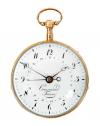   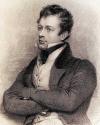 |
CAPTAIN FREDERICK MARRYAT'S GOLD POCKET WATCH, EARLY 19TH CENTURY
an 18K gold open face quarter repeating verge pocket watch with calendar, 2in. white enamel dial signed and numbered Courvoisier Frθres, 48446, with Arabic numerals, outer minute track, inner calendar ring with corresponding hand, blued steel Breguet hands; matte gilt movement, full plate, verge escapement, three-arm brass balance, flat balance spring, pierced and chased continental cock with polished steel endplate, silvered regulation dial, repeating on gongs activated by depressing the pendant; contained within a three-body, "Empire" case with polished bezels, reeded band, gilt metal counter-signed cuvette hinged to the movement ring engraved "Captn. Fredk. Marryat, RN" - 2in. (7cm.) high; together with a photocopied letter dated 1953 confirming the pedigree and line of descent, and a watch repairer's invoice dated 2010 stating the watch had been comprehensively overhauled at that time
£2500-3500
|
|
   |
CAPTAIN FREDERICK MARRYAT'S TELESCOPE
an early 19th-century 1½in. single draw mahogany and brass telescope signed by the eye-piece Worthington & Allan, London, and inscribed on cuff Captn. Marryat C.B., tapering mahogany tube with lens cap and dust slide - 25½in. (64.8cm.) closed
Nathanial Worthington & James Allan worked between 1821-1834 from 196 Piccadilly. In an interesting coincidence, these rooms sold Marryat's night glass, a rare model by Thomas Jones, as lot 72 in sale 006, October 2010.
£600-800
|
|

|
A RARE BOVEY TRACEY BLUE AND WHITE MESS BOWL, CIRCA 1870
probably a wreck find, the exterior transfer printed to front for MESS 11, flanked by depictions of Brunel's Royal Albert Bridge over the Tamar River and a busy view of Plymouth harbour from the sea; the interior transfer decorated with British patriotic symbols and foul anchors within rope border - 6½in. (16.5cm.) diameter
£250-350
|
|

|
Ø A COMMEMORATIVE TORTOISESHELL AND IVORY PLAQUE FOR H.M.S. PHOENIX, 1879
the ivory hull carved in profile and set on a blond shell plate set in tortoiseshell frame with ivory naval crown over and title under - 5¼ x 7in. (13.5 x 17.8cm.)
H.M.S. Phoenix was a 'Doterel' Class sloop of 1,130 tons launched at Devonport on 16th September 1879. Designed to serve on the North American and West Indies Station, she was wrecked almost exactly three years later on 12th September 1882 en route to Canso, Nova Scotia.
£150-250
|
|

|
TWO IMPERIAL RUSSIAN NAVAL FUSE CONTAINERS
constructed in brass and shaped with belt loops behind, hinged lids, the front of one engraved No. 41, each stamped on the underside with anchor devise and dated '1841' and '1844' respectively - 9¾in. (25cm.) wide
£400-600
|
|

|
AN HISTORICALLY INTERESTING LIFEBOAT COMPASS FROM THE HOSPITAL SHIP DOVER CASTLE, TORPEDOED 1917
of standard form, with liquid-filled compass signed John Lilley & Sons, London mounted in gimbal, brass housing with glazed port and lamp window (lamp missing) - 11½in. (29cm.) high; with letter of provenance
Provenance: Robert Sweetlove (salvaged from lifeboat no.7), to his stepson Ulric von Nesselrode, gifted to Mr & Mrs Arthur, vendor
Built for Union Castle in 1905, Dover Castle was first employed as a troopship in WWI, but was later converted to a hospital ship. At 7pm on 26th May 1917 whilst steaming 50 miles north of Bona in company the hospital ship Karapara, she was struck by a single torpedo fired by UC-67. Escorting destroyers put out a smoke screen and took wounded off. The captain hoped to save his ship when, an hour later, the submarine fired a second torpedo sending Dover Castle to the bottom within three minutes. Seven stokers were killed by the explosion, but everyone else survived in lifeboats.
£200-400
|
|

|
ADMIRALTY PUBLICATIONS OF THE EARLY DREADNOUGHT ERA
comprising: "The Visit of the French Fleet [to the Solent], August 1905", containing printed programme of events, monochrome illustrations by Eduardo de Martino, and chart printed in colour on silk in back pocket; together with another issued for "The Visit to Portsmouth, May 1907, for the official visit of the Colonial Premiers and the Houses of Parliament to view H.M.S Dreadnought and other units of the fleet including submarines", illustrated with 8 original monochrome photographs, each with labelled tissue guards, and a folding map of the dockyard; and a similar book for designed for non-specific visits, undated, and illustrated with both photographs (as the last) and coloured postcards, each sumptuously bound in full navy lambskin, with elaborately gold-blocked covers and silk endpapers, spine of the last slightly rubbed but otherwise all in excellent condition
(3)
These 'souvenir' books, the last two marked 'Not for Publication', were clearly intended for presentation to dignitaries and other distinguished guests, and all are probably rare survivals
£200-300
|
|

|
A COLLECTION OF ROYAL NAVAL SOUVENIRS
comprising two engraved brass presentation candlesticks from the Mediterranean Fleet 1906, a plated presentation cigarette box from Cammell Laird for H.M.S. Kempenfelt containing a section of her turbine blades, two engraved brass plaques for H.M.S. Hindustan and Implacable; a wood and copper cigar box for H.M.S. Dreadnought, a Royal Vistaware plate for Dreadnought and an unidentified patent for an flotation device
(a lot)
£80-120
|
|

|
A LARGE CONTEMPORARY PHOTOGRAPH OF H.M.S. DREADNOUGHT DEPICTED AFTER COMPLETING HIGH SPEED TRIALS, CIRCA 1907
inscribed in Indian ink H.M.S. DREADNOUGHT / 10240 lower left, image - 16 x 22in. (40.5 x 56cm.), framed and glazed; together with another for H.M.S. Princess Royal under tow, image - 14 x 24in. (35.5 x 61cm.) framed and glazed
(2)
£100-150
|
|

|
A RARE HAND-CARRIED COPPER AND BRASS MAGAZINE OIL LAMP, CIRCA 1900
the bevelled glass windows with external brightness and extinguishing controls stamped on the burner 'WD' with broad arrow 52 and maker's mark for Ballpit & Sons, Birmingham, with substantial turned wood carry handle - 13½in. (35.5cm.) high
£150-250
|
|

|
A LARGE QUANTITY OF NAVAL TREEN
a variety of objects from ships including Warspite, Terrible, Cambrian, Victory, Valiant, Ganges, Iron Duke, Ajax, Queen Elizabeth, Birmingham and others; together with a box made from H.M.S. Britannia, an ice bucket and bookends
(a lot)
£150-250
|
|

|
A MAGAZINE LAMP RECOVERED FROM THE GERMAN DREADNOUGHT S.M.S POSEN (1910)
hinged mauve glass lamp mounted on a wooden base with electric fittings - 10¼in. (26cm.) high; together with a boat badge from the same vessel cast in alloy and finished in polychrome, mounted on a wooden shield back with plate inscribed S.M.S. POSEN over - 10in. (25.5cm.) high
(2)
One of the first class of Dreadnoughts ordered for the German navy, Posen participated in the early raids on the English coastal towns of Scarborough, Hartlepool and Whitby in a failed attempt to lure out the Grand Fleet. She served at Jutland where her accurate gunnery sank a destroyer, but she survived undamaged. She was not handed over at Scapa Flow but was decommissioned in Germany instead. When the High Seas Fleet later scuttled, she was seized by Great Britain as compensation who sold her to the Dutch for breaking in 1920.
£150-250
|
|
  |
A SCREEN BADGE FROM H.M.S. ARK ROYAL [1914]
heavily cast in brass with depiction of the first Ark Royal, with threaded mounting points behind - 24in. (61cm.) diameter
Bought on the stocks by the Admiralty in May 1914, what had been intended as a standard collier was effectively rebuilt from the keel up for a cost of £81,000 and produced the worlds first purpose built aircraft carrier. Equipped with workshops and steam cranes, the floatplanes were launched from her decks on wheeled trolleys and landed next to her to be hoisted aboard. Although slow, she proved very useful and was deployed at the Dardanelles for gun spotting and many operations until withdrawn in May 1915 as being susceptible to U-boat attack. Renamed Pegasus in December 1934 to release the name for a new carrier, she survived until 1946 and was broken up in 1949
£600-800
|
|
| |
A 13½IN. TOMPION FROM THE BATTLESHIP H.M.S. CENTURION [1911]
cast in brass and now mounted in wooden frame inscribed H.M.S. Centurion 1916-1917 - 21½in. (55.5cm.)
Provenance: Admiral of the Fleet Roger Keyes (1872-1945), who commanded Centurion at this time
One of four 'King George V' Class battleships of the 1911 programme, they were basically improvements on the previous 'Orion' Class. Armed with 10 x 13½in.; 16 x 4in. guns and 3 x 21in. torpedo tubes, she joined the Grand Fleet in 1914 and served throughout the War with the 2nd Battle Squadron. She was lightly deployed at Jutland and, apart from four salvos at Lützow, received no hits. After a patchy inter-War career, her final act was to be sunk as a breakwater during the Normandy landings - the Germans believed their 352nd division had sunk the huge ship with great loss of life when only 70 men were seen to depart - in fact those 70 men were the entire crew!
£500-800
|
|

|
A PAIR OF 12IN. BRONZE TOMPIONS FROM THE MAJESTIC CLASS BATTLESHIP H.M.S. CAESAR [1896]
cast with a right-facing profile of Caesar with motto inscribed over AUT CÆSAR AUT NULLUS ("Caesar or Nothing"), framed within a rope border and now mounted in circuit board with suspension hook (old wear overall) - 17in. (43cm.) square
(2)
H.M.S. Caesar was one of the nine 'Majestic' class battleships ordered as a result of the so-called "Naval Scare" [about French naval expansion] of 1893. Caesar and her sisters were fine-looking vessels and represented the acme of the late Victorian Royal Navy. Sent to the Mediterranean after a short spell with the Channel Fleet, Caesar remained in Malta until October 1903 when she came home for a refit. Considered obsolete by 1914, her wartime duties, despite their usefulness, were mostly of a secondary nature and she was sold for scrapping in 1921
£300-500
|
|

|
A PAIR OF 12IN. TOMPIONS FROM THE 'LONDON' CLASS BATTLESHIP H.M.S. LONDON [1899]
cast in brass with remnant enamelling, threaded backs, now with suspension loops - 11½in. (29cm.) diameter
(2)
H.M.S. London was one of five in her class, but this was really a continuation of the three 'Formidable' Class ships of a year earlier. Like Caesar, she served in the Mediterranean initially and returned to the Channel Fleet in 1908. In WW1 she was initially deployed at Sheerness to guard against German invasion and was present when her sister ship, Bulwark, blew up at the quayside, the inquiry being held on London. She supported the landings at Anzac Cove in the Dardanelles Campaign in 1915 and a year later was sent to Rosyth for conversion to a mine layer. She was sold for scrapping in 1920 and broken up in Germany
£300-500
|
|

